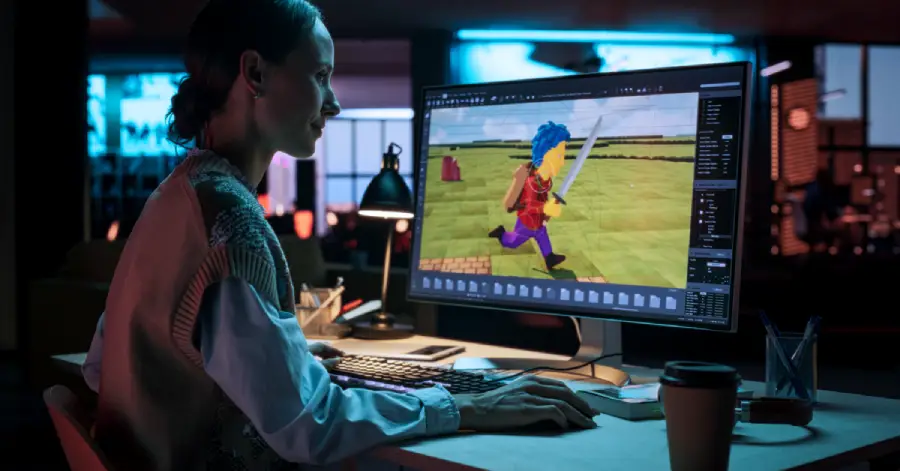The Magic Touch of Visualization and Collaboration for Effective Content Development
- Published on: June 27, 2024
- |
- Updated on: February 25, 2025
- |
- Reading Time: 6 mins
- |
-
Views
- |
Have you ever thought about the power of a picture? In the world of E-Learning, visuals are not just decorations to look pretty; they’re a fundamental element for maximizing learner engagement and knowledge retention. Studies show that visual learning techniques improve classroom learning by 400%.
But, do not consider this as simply adding images to text. It’s all about strategically using a variety of visual elements that result in learning efficacy. As we delve deeper into this blog about visualization and the collaboration of human expertise with AI, can help you create learning content that’s not only visually stunning but also culturally relevant, accessible, and efficient to develop.
Visualize Your Way To Better Learning Content
Why Storyboards Matter
Building a worthwhile learning experience demands a clear plan. Often not considered essential, storyboarding is your roadmap, blueprint, foundational tool whatever it is that you want to call it that serves in building successful learning content development. It visualizes the entire learning journey scene-by-scene allowing instructional designers to plot the sequence of events, interactions, and assessments that learners will encounter before a single line of code is written or a graphic is designed. This planning phase is crucial because it sets the stage for a coherent and well-paced learning experience.
One of the most significant advantages of storyboarding is its ability to build communication and collaboration among all stakeholders involved in the development project. A well-crafted storyboard serves as a shared vision that instructional designers, subject matter experts (SMEs), clients, and developers can all refer to before development begins, making it easier to identify and address potential issues early in the process. This common reference point makes sure everyone is aligned on the learning objectives and the planned delivery of the content, preventing costly revisions later on.
An ideal navigation path for the learner is essential in a well-thought-out storyboard. This ensures that learners can move through the content snippets intuitively, without getting lost or confused. A smooth navigation flow enhances the overall learning experience.
The three major benefits of storyboarding are:
- Plan the Flow: It determines the logical progression of the content, ensuring that each section builds upon the previous one to avoid any jarring transitions in a learner’s journey.
- Set the Pace: You can decide where to introduce new concepts when to include assessments, and how to balance information and interactive elements.
- Design the Visuals: Decide where will visual elements like images, infographics, animations, and videos be integrated into the course, to complement and improve the learning content.
What’s Next After Your Storyboards?
If storyboarding is the foundational step, these tools are what bring your ideas a visual structure:
1. Infographics: Complex information can be too much to read as general text. Infographics are a great way to condense key points and statistics into visually compelling and easy-to-understand formats. Examples like charts, graphs, and icons effectively break down data and aid in easy knowledge absorption and retention.
2. Microlearning and Animations: Bite-sized animated lessons are all the rage in digital learning currently. They can typically convey focus concepts in a visually stimulating way within 2-5 minutes. Animation injects that oomph factor and interactivity, by bringing abstract concepts to life, showcasing processes in action, and creating connections that cannot happen only with text. Microlearning’s short format makes it ideal for busy learners and learners with short attention spans, allowing them to consume information in digestible chunks.
3. Images and Cultural Relevance: We’ve all heard a picture may be worth a thousand words. But when it comes to learning content choosing the right image is very crucial. Culturally relevant visuals are essential for avoiding biases and ensuring your content resonates with a diverse audience. For instance, using local landmarks or culturally specific scenarios in examples can make learning feel more relevant and relatable. Additionally, ensuring diversity in the representation of people in your visuals helps create an inclusive learning environment. It’s also worth noting the importance of providing alt text for images to ensure accessibility for all learners, including those using screen readers.
Remember, the ultimate goal is to achieve effective learning outcomes from your courses. and the strategic use of the above aspects of visualization plays a very important role in achieving this.
The Collaborative Future of Content Development
The coming together of human expertise and tech disruptors like AI can dramatically improve the quality and effectiveness of educational content. The strengths of both human experts and AI tools create a collaboration that drives success in eLearning development. Let’s take a look:
Human Expertise Meets AI
SMEs are the foundation for building any type of learning content. They bring deep knowledge, experience, and relevance to the subjects is crucial for creating high-quality educational content. When paired with AI, this human expertise can make the entire development process efficient and effective.
AI tools can analyze large datasets to identify learning trends and patterns that SMEs might not easily see. For instance, in creating an advanced calculus module, AI can swiftly gather and structure information from various mathematical textbooks and academic papers. However, a mathematics SME can then refine this content, adding real-world applications, identifying common student misconceptions, and ensuring the flow of concepts aligns with effective teaching practices.
Bridging Cultural Gaps
The global nature of e-learning demands cultural sensitivity and human expertise is indispensable when it comes to ensuring that learning content is culturally appropriate and free from biases. While AI can provide data-driven insights, it lacks the nuanced understanding of cultural contexts that human experts possess. SMEs can identify and adjust elements that might be culturally insensitive or misinterpreted, thus making the content more universally applicable and respectful.
Efficiency with AI
Tasks like copy editing, proofreading, and formatting can be handled swiftly by AI, freeing up experts to focus on higher-level cognitive tasks such as content creation, critical analysis, and pedagogical strategy. In learning content development, AI can be particularly useful in:
1. Copy editing and proofreading content quickly for grammatical errors, spelling mistakes, and inconsistencies in style.
2. Content tagging with relevant metadata to organize and retrieve information easily.
3. Content generation for topics with standardized information. AI can generate first drafts, which experts can then refine and enhance.
Digital Migration of Content
Many publishers have a wealth of legacy learning materials trapped in outdated formats. With the right digital migration experts, the learning content can be restructured to fit digital needs, update any outdated content, add visualization tools and interactive elements, and also make sure the content meets current accessibility standards
For example, when migrating a traditional textbook to an interactive eLearning module, these experts might break down long chapters into micro-learning units, add quizzes and interactive exercises, and ensure that all images have proper alt text for screen readers.
Leveraging AI & Outsourcing
Outsourcing to experts who are also well-versed in AI offers a balanced approach to managing repetitive tasks while maintaining quality and cost-effectiveness. AI can handle bulk tasks quickly, while an outsourced team of experts can provide the necessary oversight and refinement.
This allows learning providers to scale operations quickly for large projects, maintain consistent quality across large volumes of content, and reduce costs while improving turnaround times.
Conclusion
We explored the importance of two powerful forces – visualization and collaboration to create successful learning content that drives outcomes. At Magic, our team experts excel at crafting clear and engaging visualization tools, ensuring your content flows seamlessly. We leverage the power of AI freeing up our SMEs on what matters – creating learning content that aligns with objectives. Get in touch!
FAQs
Visuals enhance learner engagement and knowledge retention. They are not just decorative but serve as crucial tools to improve learning outcomes by making content more accessible and memorable.
Infographics, microlearning animations, culturally relevant images, and interactive elements can all be used to make learning content more engaging, accessible, and effective. These elements help in breaking down complex information and keeping learners interested.
Ensuring cultural relevance and inclusivity in visual elements involves thorough research to understand the cultural backgrounds and preferences of your target audience. Incorporate diverse representations in your visuals, such as images and scenarios that reflect various ethnicities, genders, and cultures. Consult with cultural experts to review and provide feedback on your content to avoid biases and ensure it resonates with a diverse audience. Additionally, include descriptive alt text for all images to support accessibility for learners using screen readers, ensuring that your content is inclusive to all.
Best practices for integrating AI into e-learning content development include leveraging AI for repetitive tasks such as copy editing, formatting, and tagging to streamline the process and save time. Use AI to analyze learner data and identify trends, allowing for personalized and improved content. Employ AI to generate initial drafts of standardized information, which can then be refined by human subject matter experts to maintain quality and relevance. Collaboration between AI tools and SMEs ensures content accuracy and cultural sensitivity, while continuous updates to AI tools and processes based on feedback and technological advancements keep the e-learning content effective and up-to-date.

Get In Touch
Reach out to our team with your question and our representatives will get back to you within 24 working hours.


